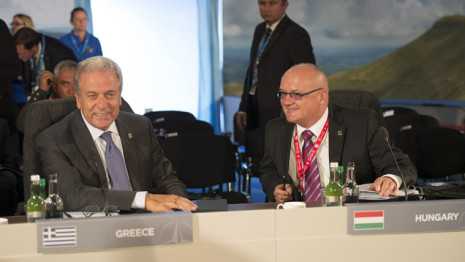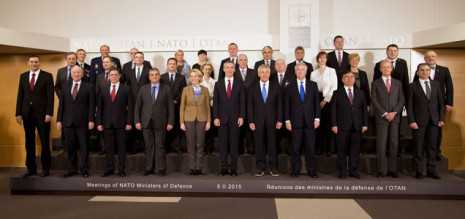Csaba Hende: Hungary asks for a NATO Force Integration Unit to be set up on its territory
Szöveg: honvedelem.hu / MTI | 2015. február 6. 13:30At the meeting of NATO Ministers of Defence held in Brussels in the afternoon of Thursday, February 5, Minister of Defence Csaba Hende proposed that a 40-strong command and coordination centre be set up in Hungary too, the Minister of Defence told Hungarian reporters.
“This unit would serve Hungary’s security, it would not be directed against any country and would not violate in a legal or political sense the NATO–Russia Founding Act of 1997", the Minister emphasised, adding that the NFIU only has advantages as it strengthens Hungary’s security, makes the defence of the country more effective and enables faster cooperation with NATO. “Those attempting to present any challenges to Hungary will think twice about doing it even more than before, because the NFIU will facilitate immediate response and allow us to take steps faster than ever", Minister Hende said, and went on to highlight the development of Pápa Air Base, which can receive a NATO brigade arriving in Hungary when necessary.
Minister Hende also noted that the most practical solution would be to set up the NFIU at an already existing operational command. The HDF Joint Force Command is located in Székesfehérvár, which is a reason for the NFIU to be placed there in the interest of maximum effectiveness. “This measure is meant to increase Hungary’s security, and with a small investment, it will significantly enhance the credibility of the defence of the country, and thereby Hungary’s security", the Minister explained.

Minister of Defence Csaba Hende at the NATO Wales Summit in last September
At the Wales Summit in last September, leaders of NATO member states made a decision on setting up the NFIUs. Six countries – the Baltic States, Poland, Romania and Bulgaria – have already indicated their willingness to host such centers. The primary mission of the NFIUs is to facilitate the fastest possible reception of the Very High Readiness Joint Task Force (VJTF) by eastern members of NATO.
Furthermore, the NFIUs will participate in organizing and supporting multinational exercises and execute general liaison tasks as well. The decision about these was also made at the Wales Summit with the aim of enabling NATO to deploy a 5000-strong force anywhere on the territory of the Alliance within 48 hours. NATO drew up the Readiness Action Plan in response to the crisis in Ukraine, with the aim of strengthening the defence capabilities of the Alliance in the eastern member states. According to Minister Hende, there isn’t any collective defence infrastructure in these countries, and they asked NATO to relocate some of its capacities, which seemed to be a rightful but costly request. As a compromise solution, a decision has been made to create a rapid deployment brigade-sized force together with these joint small commands which can receive it.

For the time being, Minister Hende has not disclosed details of Hungary’s participation in the VJTF. As he said, the military planning of this participation is in progress. “Hungary would like to make a significant troop contribution to the Very High Readiness Joint Task Force", the Minister of Defence said.
Minister Hende also told the press that the NATO Nuclear Planning Group had met during the day, and its members agreed that NATO must maintain its nuclear defence capabilities as long as there are nuclear weapons in the world. The Minister also said that the representatives of the Alliance had met with the Defence Minister of Georgia to take stock of the implementation of the Substantial NATO–Georgia Package. They concluded that Georgia has implemented huge reforms and made significant progress in the modernization of the defence sector. Hungary has offered to contribute a logistic expert to the NATO–Georgia Joint Training and Evaluation Centre to be established in Georgia, and to provide the officers of Georgia and other partner nations with opportunity to learn English in Budapest.
Photo: nato.int and archives